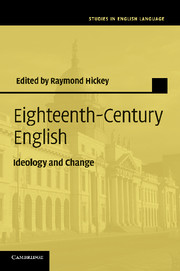Book contents
- Frontmatter
- Contents
- List of figures
- List of maps
- List of tables
- Notes on contributors
- Preface
- 1 Attitudes and concerns in eighteenth-century English
- 2 Prescriptivism and the suppression of variation
- 3 Women's grammars
- 4 Eighteenth-century women and their norms of correctness
- 5 Lowth as an icon of prescriptivism
- 6 Queeney Thrale and the teaching of English grammar
- 7 Coalitions, networks, and discourse communities in Augustan England: The Spectator and the early eighteenth-century essay
- 8 Contextualising eighteenth-century politeness: social distinction and metaphorical levelling
- 9 Expressive speech acts and politeness in eighteenth-century English
- 10 Variation and change in eighteenth-century English
- 11 Variation in sentential complements in eighteenth- and nineteenth-century English: a processing-based explanation
- 12 Nationality and standardisation in eighteenth-century Scotland
- 13 English in eighteenth-century Ireland
- 14 Changes and continuities in dialect grammar
- 15 ‘Be pleased to report expressly’: the development of a public style in Late Modern English business and official correspondence
- 16 Registering the language – dictionaries, diction and the art of elocution
- Timeline for the eighteenth century
- References
- Late modern English language studies
- Indexes
5 - Lowth as an icon of prescriptivism
Published online by Cambridge University Press: 06 December 2010
- Frontmatter
- Contents
- List of figures
- List of maps
- List of tables
- Notes on contributors
- Preface
- 1 Attitudes and concerns in eighteenth-century English
- 2 Prescriptivism and the suppression of variation
- 3 Women's grammars
- 4 Eighteenth-century women and their norms of correctness
- 5 Lowth as an icon of prescriptivism
- 6 Queeney Thrale and the teaching of English grammar
- 7 Coalitions, networks, and discourse communities in Augustan England: The Spectator and the early eighteenth-century essay
- 8 Contextualising eighteenth-century politeness: social distinction and metaphorical levelling
- 9 Expressive speech acts and politeness in eighteenth-century English
- 10 Variation and change in eighteenth-century English
- 11 Variation in sentential complements in eighteenth- and nineteenth-century English: a processing-based explanation
- 12 Nationality and standardisation in eighteenth-century Scotland
- 13 English in eighteenth-century Ireland
- 14 Changes and continuities in dialect grammar
- 15 ‘Be pleased to report expressly’: the development of a public style in Late Modern English business and official correspondence
- 16 Registering the language – dictionaries, diction and the art of elocution
- Timeline for the eighteenth century
- References
- Late modern English language studies
- Indexes
Summary
Introduction
Following the curious description of Robert Lowth (1710−87) as a philologist ‘more inclined to melancholy than to mirth’, the Oxford Companion to the English Language (OCEL) notes that Lowth's ‘name has become synonymous with prescriptive grammar’ (McArthur 1992, s.v. ‘Lowth’). Lowth's Short Introduction to English Grammar was first published in 1762, and was frequently reprinted during the eighteenth century. Writing more than a century and a half before the OCEL, one William Hill, in the fourth of his Fifteen Lessons, on the Analogy and Syntax of the English Language, observed that ‘Bishop Lowth … may well be accounted the Father of English Grammar’ (Hill 1833: C4r). Usually, this epithet is reserved for Lindley Murray (1745–1826) (Nietz 1961: 110; Tieken-Boon van Ostade 1996: 9), the author of the phenomenally popular English Grammar (1795) who had used Lowth's grammar as one of his major sources (Vorlat 1959). As the bibliographical account provided in Alston (1965) shows, Murray's grammar was considerably more popular than Lowth's, and he may therefore be held responsible for giving wider currency to Lowth's grammar and the notions expressed in it. What writers like Nietz (1961), and Hill before him, mean by ‘grammar’ comprises the results of well over two centuries of prescriptivism, resulting in a vast number of rules of correct usage that have come to be laid down in linguistic handbooks and usage guides such as Fowler's Modern English Usage (1929), the third edition of which, edited by Burchfield, appeared in 1996.
- Type
- Chapter
- Information
- Eighteenth-Century EnglishIdeology and Change, pp. 73 - 88Publisher: Cambridge University PressPrint publication year: 2010
- 7
- Cited by



